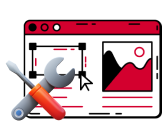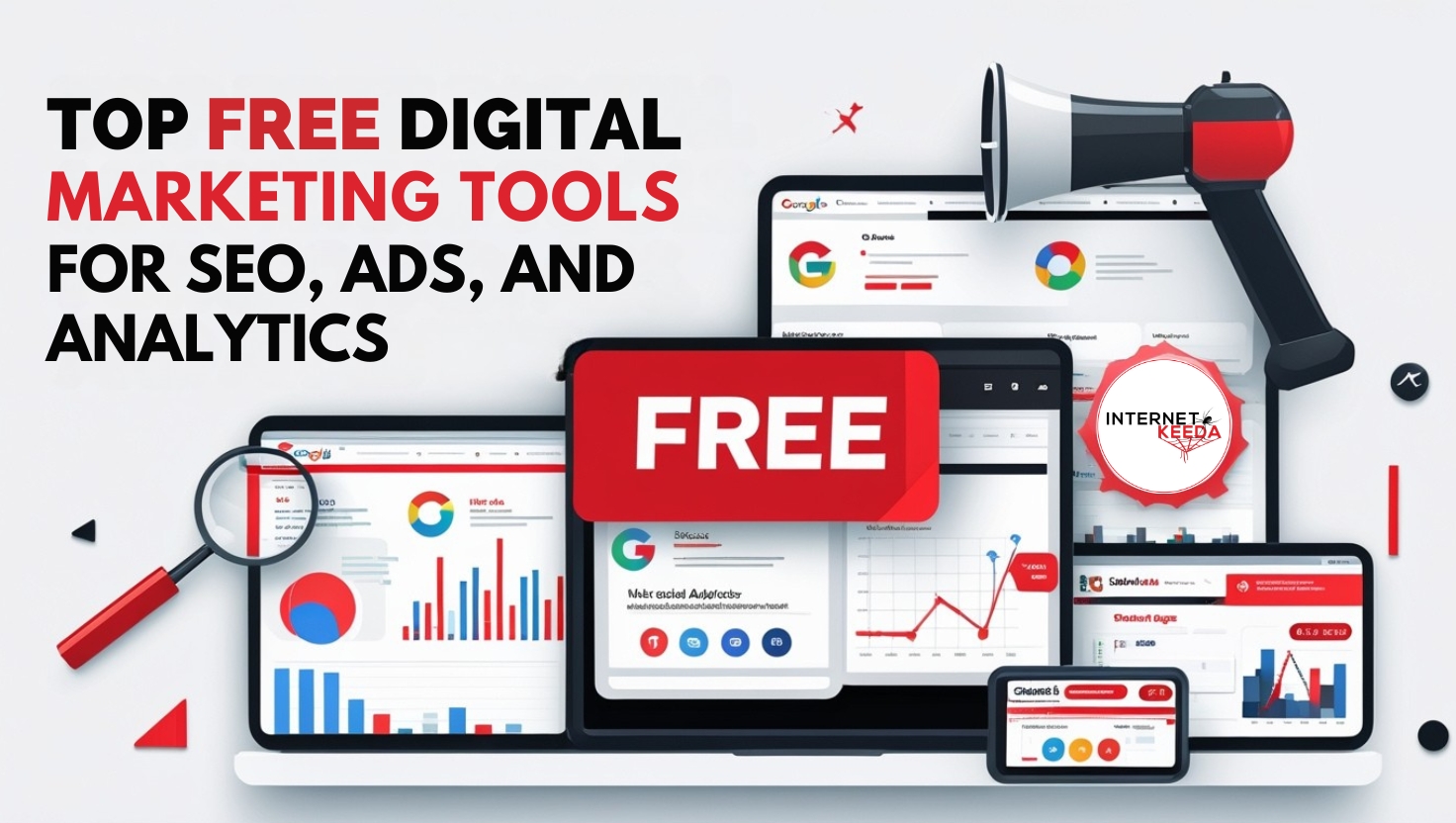Introduction: Where Ambition Meets Constraints
If you’ve ever sat in front of your laptop, juggling five tabs while sipping a third cup of chai, wondering how to scale your business or content with zero budget left for tools, you’re not alone. This is where most marketers begin their journey. The ambition is clear. The vision is alive. But the resources? They’re tight. You know digital marketing matters. You’ve read enough headlines telling you to “optimize your funnel” or “scale your ad ROI,” but how do you do all that when even a single pro software subscription feels out of reach?
It’s a real problem. And here’s the truth:- paid tools are great, but they’re not your only option. There’s a suite of free tools out there that may not have flashy logos or billion-dollar ad budgets behind them, but they work. They work exceptionally well. Some of them are from global tech giants. Others are indie gems created by developers who once stood where you are right now, trying to get noticed without getting buried under costs.
This guide is for the self-taught marketers, small business warriors, freelancers trying to break even, and creators figuring things out one search query at a time. We’re going deep into the world of free digital marketing tools for SEO, for ads, for analytics, and, more importantly, how to use them to make a real difference. You won’t just get a list. You’ll gain insight, context, and a practical understanding of how these tools fit into your workflow and how they can help you work smarter, not just harder.
So whether you’re managing a blog that brings in a few hundred visitors a month or an online store with your first ten customers, this is your launchpad. These tools might be free, but the growth they can unlock is priceless. That’s priceless.
Free SEO Tools That Work Without Compromise
Getting seen online depends heavily on SEO, but that doesn’t mean you need to spend a fortune to make an impact. Some of the most powerful tools for improving your search rankings are completely free. What matters is how you use them. These tools won’t just save you money, they’ll save you time and help you make better, smarter decisions that move your website forward.
Start with Google Search Console. It may not have the gloss of fancy dashboards, but it gives you something more valuable:- direct window into how Google sees your site. You can track which keywords are driving traffic, which pages are getting noticed, and where you’re starting to lose visibility. Every time you publish content or optimize an old page, Search Console becomes your proof of progress. If you know how to read its performance reports, you can turn vague ideas into content strategies that are grounded in data.
Next, there’s Google Trends, one of the most underutilized tools in marketing. It won’t hand you keyword difficulty or backlink profiles, but it does something just as important. It tells you what your audience is curious about right now. You can compare search interest over time, spot regional differences, and catch the rise of new trends before they’re everywhere. For small businesses trying to stay agile, knowing when to shift focus based on search behavior can be a game-changer.
Then comes Ubersuggest, a tool that strikes a balance between user-friendly and insight-rich. Even with the free plan, it offers keyword suggestions, traffic estimates, content ideas, and competitor analysis. It gives you enough information to make good decisions without overwhelming you with data you don’t need. For creators, freelancers, and small agencies, it’s often more than enough to plan blog posts, improve site content, or figure out what your competitors are ranking for.
Another tool that digs deeper into user intent is AnswerThePublic. This one doesn’t just give you keywords. It shows you real questions people are asking about a topic. These questions are what make up the heart of good SEO content. They reflect curiosity, frustration, hope, and confusion, real emotions behind search behavior. If you’ve ever wanted your blog to feel more human and more useful, starting with questions from this tool helps you write with empathy and precision.
And for those who like to audit websites on the fly, SEO Minion deserves a spot in your toolkit. It’s a browser extension that checks meta tags, analyzes links, highlights missing alt text, and helps you catch small issues before they become bigger problems. It’s simple, but effective, especially if you’re doing your SEO without the luxury of a technical team behind you.
These tools do more than just save time. They train you to think differently about content. They push you to observe patterns and trends. They help you understand what people are looking for and how your site can meet that need. In India’s fast-moving digital economy, this kind of clarity is critical. Whether you’re managing a brand on your own or guiding a small team, these tools let you compete without draining your resources.
Free Advertising Tools That Help You Stretch Every Rupee
Running ads is often where small businesses feel the squeeze. You know you need visibility, but paying for every impression or click can quickly drain your budget. The good news is, there are tools out there that don’t just help you run ads, they allow you to do it wisely. And many of them are free or offer enough value without forcing you into a paid plan right away.
Google Ads Keyword Planner is often misunderstood. Most people see it as a tool only for advertisers, but it’s much more than that. Even if you don’t plan to launch a full campaign, you can use it to uncover what people are searching for, how competitive those terms are, and which ones might cost more than others. For small businesses in India trying to understand local demand, this tool offers real-time insight into where consumer attention is going. You might discover that a low-cost, long-tail keyword gets more clicks in Lucknow than it does in Delhi, and that tiny detail can shape your entire content or ad strategy.
Meta’s Ads Library is another underrated gem. It won’t give you ad creation tools, but it lets you see exactly what kinds of Facebook and Instagram ads are running at any given moment. You can look up any competitor, big brand, or even your favorite startup, and peek behind the curtain at what they’re promoting. It’s not about copying. It’s about understanding tone, visuals, and messaging that work, then adapting them to your brand. If a small D2C brand in Surat is using bold product imagery and quirky taglines to drive conversions, you might rethink your approach instead of spending hours trying to guess what resonates.
Then you’ve got Canva’s free ad templates. Canva is everywhere for a reason. It allows non-designers to create professional-looking graphics with minimal effort. For ad creatives, this means no more relying on outdated designs or freelancers who take a week to deliver one banner. You can produce carousel ads, video thumbnails, Google ad images, and product promos within minutes. The latest templates are optimized for different platforms, whether it's vertical videos for Instagram Reels or square images for Google Display.
If you’re experimenting with video ads, Clipchamp by Microsoft has started to gain real traction in the creator and marketer communities. It’s free, browser-based, and surprisingly powerful. With built-in templates, voice-over features, and text animation, it’s now a favorite among freelancers and small teams trying to stand out in crowded feeds. You don’t need a big camera setup or post-production knowledge, just an idea and a bit of storytelling.
And then there’s Bitly. On the surface, it’s just a link shortener. But its free tracking features let you monitor where your traffic is coming from, which campaign performed better, and what platforms bring the most clicks. When every rupee spent on ads needs to bring back value, these small insights make a big difference. You start understanding whether your WhatsApp links perform better than your Instagram ones, and where to double down.
What ties these tools together is not just that they’re free. It’s that they teach you to pay attention. In a country like India, where digital advertising is growing faster than most businesses can keep up with, these tools give you the edge you didn’t know you needed. You’re not just running ads, you’re learning how people respond, when they pay attention, and what makes them act.
Free Analytics Tools That Turn Chaos Into Clarity
Running a business often feels like trying to drive through fog. You’re moving, but you’re not always sure where you’re going or what’s ahead. That’s where analytics tools come in. They clear the fog, showing you what’s working, what’s not, and what needs attention. And the best part? Some of the most insightful tools don’t cost a thing.
Let’s start with Google Analytics 4. It’s not just the industry standard, it’s the digital nervous system of any modern business. Yes, it’s more complex than its earlier version. But once you get comfortable with it, GA4 gives you visibility across your entire customer journey. You can track how users land on your site, what pages they explore, how long they stay, and what eventually gets them to buy or leave. For a small business owner, this is gold. It turns gut feelings into measurable insights. You stop guessing and start understanding patterns. Maybe your blog pulls in traffic, but your product pages aren’t converting. Or maybe visitors from a certain city bounce faster than others. These are not just numbers, they’re clues.
Next, there’s Microsoft Clarity. It doesn’t just tell you what happened on your website. It shows you. With free heatmaps, session recordings, and click data, Clarity lets you watch user behavior in real-time. You see where people hesitate, scroll too fast, or completely miss your call to action. It’s like sitting behind the shoulder of every visitor without invading their privacy. And that’s a perspective few paid tools can match. For startups testing new landing pages or entrepreneurs trying to fix their checkout process, this level of visibility feels almost unfair, like you’re getting secrets the big brands used to keep to themselves.
Another underrated tool is Fathom Analytics. While the free version has some limitations, its privacy-first design and simplified reporting make it a favorite among solopreneurs who want to focus on what matters without getting buried in data. You don’t get every possible metric, but what you do get is clear, relevant, and easy to explain to your team or clients. Sometimes, simplicity is the smartest strategy.
For those leaning into content marketing, Google’s PageSpeed Insights might not sound like an analytics tool, but it plays a critical role. If your site loads too slowly, users leave before you even get a chance to engage them. Speed directly affects bounce rate, conversion, and even search ranking. This tool tests your performance and tells you exactly what to fix, from compressing images to reducing third-party scripts. And it updates with every major Core Web Vitals change, keeping you on Google’s good side.
And for social insights, Meta’s built-in analytics for Facebook and Instagram can still be incredibly powerful, even in their free form. You can track which posts get the most engagement, what times your audience is most active, and how paid promotions are stacking up against organic ones. These small learnings help refine your messaging, adjust your timing, and boost your ROI without spending more money.
These analytics tools do more than report metrics. They become your compass. They tell you when you’re drifting, when to push harder, and when to pull back. And perhaps more importantly, they build confidence. They remind you that even the most chaotic weeks in marketing can be measured, understood, and eventually improved.
When Smart Becomes Free: AI Tools That Do the Heavy Lifting
There was a time when access to artificial intelligence felt reserved for enterprise giants with deep pockets. Now, the playing field is shifting. Small businesses, freelancers, and early-stage startups can tap into the same powerful engines, and some of them don’t cost a thing. These AI tools are quietly changing how we work, not by replacing people, but by giving them leverage.
One standout here is ChatGPT Free, powered by OpenAI. Even without the pro version, it gives entrepreneurs a leg up. Whether you’re stuck writing product descriptions or need fresh ideas for Instagram captions, it’s like having a thought partner who never gets tired. You don’t have to start from scratch anymore. You prompt, it responds, and you refine. The loop is fast. And the result? Hours saved every week and fewer mental blocks. For many business owners juggling marketing with everything else, this alone is a gift.
Then there’s Canva’s free plan, which has become more intelligent thanks to its AI integrations. Smart resize features, design suggestions based on your input, and even text generators all live within a drag-and-drop interface anyone can master. What used to require a designer or expensive tools can now be done in minutes with a few clicks and some creative direction. For small teams running lean, this is more than a time-saver. It’s a visibility booster. Your brand starts to look more polished, more professional, more consistent, even when you're figuring things out as you go.
On the SEO side, tools like NeuralText and WriteSonic offer limited but powerful free access to AI-driven content optimization. You input a topic, and they suggest outlines, titles, keywords, and even full blog drafts that are aligned with search intent. It doesn’t replace a writer. But it’s a fantastic jumpstart. Especially for founders who wear ten hats, having a ready-made outline is like walking into a conversation that’s already halfway complete.
If you’re managing ads, then look at Predis.ai. Its free plan allows you to generate ad creatives with visuals, captions, and call-to-action options based on your brand and product. For someone trying to test messaging or explore variations quickly, it removes the weight of guesswork. You don’t need to hire a strategist to start experimenting. You just need the right prompt.
Let’s not forget Google Gemini, previously Bard, which is now integrated into Google Workspace for free. This tool answers strategic questions, helps brainstorm campaigns, and even supports content writing directly inside Gmail or Docs. It’s not perfect, but it’s evolving fast. And when used well, it saves hours of bouncing between apps or waiting for inspiration to strike.
What’s most inspiring about these tools isn’t just their cost, it’s their potential. They help people move faster without losing quality. They enable smaller teams to produce work that looks like it came from a much bigger operation. And they create space, the kind of mental breathing room you only realize you needed once you’ve got it.
With AI now accessible to anyone with an internet connection, the old barriers are starting to fall. Great ideas no longer stay stuck because someone couldn’t afford a software license. Execution isn’t held up by a lack of time or expertise. And innovation? That’s no longer something you wait for. It becomes something you start building right now.
Real Businesses. Real Hustle. Real Results.
When you scroll through social media or read case studies, it’s easy to think that success in digital marketing just clicks into place. But the truth, the kind that doesn’t always get shared, is that for most small businesses and solo founders, the journey is built on tired nights, blurry mornings, and a lot of figuring things out along the way.
Take Kavya, for example. She runs a tiny handcrafted jewellery business out of Jaipur. No marketing degree. No team. Just a passion for design and a head full of dreams. She started by watching free YouTube tutorials and using Canva’s free AI tools to create her product catalogues and Instagram visuals. Her captions? Written with the help of ChatGPT. Her audience grew from 500 to over 14,000 in less than eight months, and sales followed not because she cracked some algorithm, but because her visuals started to feel professional and her posts spoke with confidence.
Then there’s Prashanth, who manages a family-run spice export business from Kochi. He knew SEO could help his site rank better, but agencies quoted him more than he could afford. So he used free plans from UberSuggest and WriteSonic to guide his keyword planning and blog writing. Every Sunday evening, he would sit at his kitchen table, writing one blog post at a time. Within six months, his organic traffic doubled. His first international order came from a customer in Canada who found him through a blog titled “How Kerala Spices Are Changing Global Kitchens.”
Even unicorn founders started somewhere. Zepto, one of India’s fastest-growing grocery delivery platforms, wasn’t built overnight. In interviews, its co-founders have often spoken about the importance of lean experimentation. While they had funding, they still tested ad creatives using free tools before investing in larger campaigns. They understood something many overlook if a simple idea works in a small test, then it's ready for scale.
What unites stories like these is not just the use of digital tools, but the mindset. These founders and creators didn’t wait for the perfect moment. They used what was available. They learned as they went. And they trusted that consistency, paired with the right tools, would move the needle.
In a country like India, where digital transformation is happening fast, the willingness to adapt is what separates stagnant businesses from those that quietly grow. The tools are just part of the story. The grit and resourcefulness behind how they’re used is where the magic happens.
The narrative around digital marketing is changing. It's no longer about chasing trends or mimicking global brands. It's becoming about finding what works for you, using what you have, and trusting that small progress adds up. These AI tools, especially the free ones, aren't shortcuts. They're silent companions. They remove friction so you can keep moving. They bring structure when everything feels scattered. And most importantly, they help you tell your story the way only you can.
Different Hustles. Same Tools. Unique Wins.
Not every business in India looks the same, and neither do their needs. The magic of free digital marketing tools is how adaptable they are. Whether you're selling artisanal soaps from a corner in Himachal or running a B2B consulting service in Bangalore, these tools can be molded to fit your rhythm.
Let’s start with service-based businesses. Say you’re a freelance graphic designer in Indore or a yoga instructor in Hyderabad. You don’t need a full-fledged CRM or a massive ad budget. But you do need to stay visible, present your work well, and communicate consistently. Tools like Buffer, Canva, Mailchimp’s free plan, and ChatGPT can carry your entire workflow. Scheduling posts, building email lists, creating lead magnets, and drafting newsletters, all of it can be done without paying a rupee, at least in the early stages. More importantly, these tools let you automate without losing your voice.
Now, think about product-based businesses. You might be running an online store for handmade textiles, selling vegan snacks, or managing a stationery brand on Shopify. Your concerns are different. You need engaging product descriptions, appealing visuals, and tools to analyze traffic and user behavior. Google Analytics still reigns supreme here, along with Hotjar’s free version for behavior tracking. For SEO, Google Search Console and Ahrefs' Webmaster Tools offer powerful insights. If you’re not using them yet, you’re driving blind on a crowded highway.
For B2B startups or SaaS founders, visibility and content are your lifelines. You may not sell through Instagram posts, but you live and breathe by thought leadership. Tools like Grammarly, Hemingway Editor, and Ubersuggest help fine-tune your messaging. Blog posts written with the help of AI assistants like Jasper or Notion AI can cut your research time in half. Free LinkedIn analytics tools give you clarity on what content performs best, which is crucial when trying to position yourself as an industry voice.
And what about educators and coaches? India’s creator economy is booming with tutors, finance mentors, fitness experts, and public speaking coaches turning Instagram into classrooms. Tools like CapCut, Flick, and Metricool bring structure to their content schedules. AI script generators, caption assistants, and hashtag analyzers help stretch their reach without needing to spend more time or money.
Even NGOs and nonprofits often operate on tight budgets, have found allies in these tools. Whether it’s reaching donors through email, creating digital campaigns to raise awareness, or building simple websites, the combination of WordPress, Mailchimp, and design tools like Canva creates a professional foundation with zero capital investment.
What ties all of this together is how free digital marketing tools democratize growth. They level the playing field in a country where the startup ecosystem is exploding, but capital isn't always easy to access. They let passion projects become profitable, allow side hustles to go full-time, and give regional businesses a national voice. These tools, while simple on the surface, are redefining access.
And yet, the tools alone aren't the magic. The spark comes from how people use them. It’s about the founder in Surat who taught herself SEO through free HubSpot Academy courses. The food truck owner in Chennai who started tracking Instagram engagement and doubled her weekend orders. The wedding photographer in Udaipur who turned to CapCut’s free features to make highlight reels that went viral. Each story proves that when the right tool meets the right intent, transformation happens quietly but powerfully.
In a digital age where attention is scarce and expectations are high, using the right mix of tools isn’t just smart, it’s essential. But more than that, it’s empowering. It reminds entrepreneurs that their dreams don’t need to wait for perfect funding or massive teams. They just need consistency, clarity, and a little bit of digital intuition.
How Small Teams Can Punch Above Their Weight
There’s a certain grit in how small teams operate. The late nights, the multitasking, the balance between running ads and replying to customer messages on Instagram. These teams don’t have departments. They don’t have managers for every role. What they have is trust, urgency, and an insane drive to build something from the ground up.
But no matter how passionate the team is, time is still the biggest bottleneck. That’s where digital marketing tools step in, not just as software, but as extra hands. The kind that never sleeps, never gets tired, and always stays one step ahead.
Let’s say your entire team fits into one coffee table. You’re a three-person crew handling product, customer service, marketing, and logistics. You’re ambitious, but you don’t have the hours to do everything perfectly. Instead of trying to be everywhere, you get smarter about your workflow.
Start with content. You don’t need to create new material every day. Repurpose what works. Use a tool like Buffer to schedule that post you spent 90 minutes crafting across three platforms over the week. Let ChatGPT help you write different versions of your call to action. Canva gives you the design polish that once required hiring a freelancer. All of this lets your team look bigger than it is.
On the analytics front, Google Analytics and Search Console become your data department. They tell you who’s coming to your site, what’s working, and what’s not. There’s no guesswork. Your decision-making tightens, your marketing spend becomes smarter, and your team doesn’t waste time shooting in the dark.
Email marketing might sound complicated until you realize that tools like Mailchimp and Brevo have free plans that do 80 percent of what big enterprise tools offer. They let you build a sequence once and automate it forever. Someone signs up for a freebie or downloads your pricing guide? They instantly get nurtured with a five-email series written in your tone. The best part? You write it once. Then you move on to building other parts of your business.
SEO used to feel like a monster, especially when you’re small. But now, with tools like Ubersuggest, AnswerThePublic, and Google Trends, your team can find content ideas in minutes. You don’t need to be a keyword guru. You just need to know how to use what these tools reveal. Write consistently. Track progress. Refine your pages as you learn. Suddenly, your blog starts ranking. And those rankings don’t cost you anything but effort.
Customer engagement used to mean hiring someone to be online all the time. Now, even that’s changed. You can set up simple chatbots, create FAQs with Jasper, and even build WhatsApp flows through free platforms that guide visitors to what they need. You stay present without having to always be available.
What’s beautiful about all this is that your small team gets to focus on growth, not just maintenance. You’re not buried in repetitive tasks. You’re building. Testing. Adapting. Making strategic moves that used to be out of reach unless you had a full marketing department.
Even your learning curve flattens. With platforms like HubSpot Academy, Google Skillshop, and Meta Blueprint, your team can pick up essential skills in digital marketing for free. It’s not about fake certifications. It’s about real knowledge, applied fast.
The story of small businesses in India has always been about doing more with less. These tools don’t take away the hustle, they just give that hustle a boost. They help you show up consistently. They help you compete without compromise. And they quietly remind you that being small doesn’t mean staying small forever.
Automation Is Quietly Empowering Small Businesses
There’s a shift happening across Indian small businesses, and it’s not loud. It’s not flashy. But it’s powerful. More founders are realizing that the only way to scale without burning out is to automate what doesn’t require their personal touch. It’s not about replacing human input. It’s about preserving it for the work that moves the needle.
When you’re a team of one or two, every hour is a decision. Do you spend it on strategy or execution? On building the brand or replying to the fifth “Is this in stock” DM? This is where tools like Zapier, Mailchimp, and Buffer start to carry real weight. A customer makes a purchase, and the tool sends them a thank-you email automatically. You schedule Instagram posts on a Sunday, and they drip out all week while you’re meeting suppliers or packing orders.
For many small brands, automation is no longer a luxury. It’s survival. It’s the reason a candle business in Ahmedabad can handle 200 orders a month without missing a step. Or how a home-based apparel label in Chennai can launch new collections every quarter without being overwhelmed.
But automation doesn’t just save time. It creates consistency. And in marketing, consistency beats perfection. A well-timed follow-up email can outperform a fancy campaign. A social post that goes out on schedule builds more trust than a random viral reel. These small touches add up, and customers notice them, even if they don’t say it out loud.
The best part? You don’t need to know code. You don’t need an MBA. Most of these tools are built with the assumption that the person using them is learning on the go, figuring things out late at night after their full-time job or between feeding their kids and managing the household. The software has caught up to the reality of the Indian entrepreneur. It’s smarter, simpler, and it gets out of your way.
And when you finally see a notification that says “automation successful” or “campaign delivered,” it’s not just a message. It’s a quiet reminder that you’re building something real. That your systems are running, your presence is growing, and you’re not stuck doing everything yourself anymore.
When the Right Tools Feel Like a Team Member
Sometimes, digital marketing doesn’t feel like marketing at all. It feels like multitasking with too many tabs open. A sales campaign here, an SEO audit there, a half-drafted social media post, half-drafted, and a WhatsApp order coming in while your coffee goes cold again. For small business owners, especially in India, this isn’t a scenario. It’s their daily rhythm.
And when you finally start using the right digital tools, something subtle but powerful happens. The chaos gets a little quieter. The day gets a bit more structured. Instead of reacting to every ping and notification, you begin planning. You start choosing what to focus on, because automation is already handling the routine. It’s almost like hiring a silent team member who works 24/7 and never needs chai breaks.
Take Google Search Console, for example. It quietly tracks how people find you online. You don’t need to check every day, but when you do, the data’s sitting there, waiting to guide your next blog or product description. Tools like Ubersuggest or AnswerThePublic show you what your audience is searching for before they ever land on your site. Suddenly, your marketing isn’t based on guesswork anymore. It’s tuned into what people want to read, watch, or buy.
Even something as simple as using Meta Business Suite to schedule posts or track ad performance removes the guesswork from Facebook and Instagram. And when you stop guessing, you save not just time but also energy. You can use that energy to create better designs, shoot a new reel, or talk directly to your customers with more clarity.
Many founders make the mistake of thinking they need to figure everything out manually. They wear every hat. They get stuck designing posters in Canva, trying to calculate ROI from memory, rewriting the same product descriptions for the fifth time. But here’s the thing. You’re not supposed to do it all. That’s what smart businesses learn early. The goal isn’t to work harder than everyone else. The goal is to make your work count more.
What digital tools give you is space. Not just in your schedule, but in your head. They free up the bandwidth you need to think, to dream, to plan instead of just catching up. You can’t put a price on that clarity.
In the end, the real win isn’t just seeing your traffic grow or orders increase. It’s waking up without dread because you know your system is working. It’s logging in to see a week’s worth of content already lined up, your analytics updated, your leads tagged and organized. It’s feeling like your business is finally under your control, not the other way around.
Closing: Your Growth Doesn’t Need to Wait
If you’ve read this far, you already know one thing. You’re not just looking for tools. You’re looking for time. You’re looking for systems that can work with you, not against you. And you’re looking for ways to grow that don’t drain your energy or your savings.
Digital marketing is no longer a space reserved for big budgets or global teams. It’s a toolkit that’s already in your hands. Whether you’re just launching or trying to break through the next growth ceiling, these free tools are not shortcuts. They’re support systems. They help you build a brand that lasts.
Small businesses in India aren’t waiting anymore. They’re moving. Quietly. Strategically. Authentically. And if you start using these tools with consistency and care, there’s no reason your brand can’t be the next one someone searches for, shops from, and talks about.
It’s not just about saving time. It’s about using it better. And that, more than anything, is what fuels real growth.
 Bundles
Bundles Flash Sales
Flash Sales






















Comments (0)